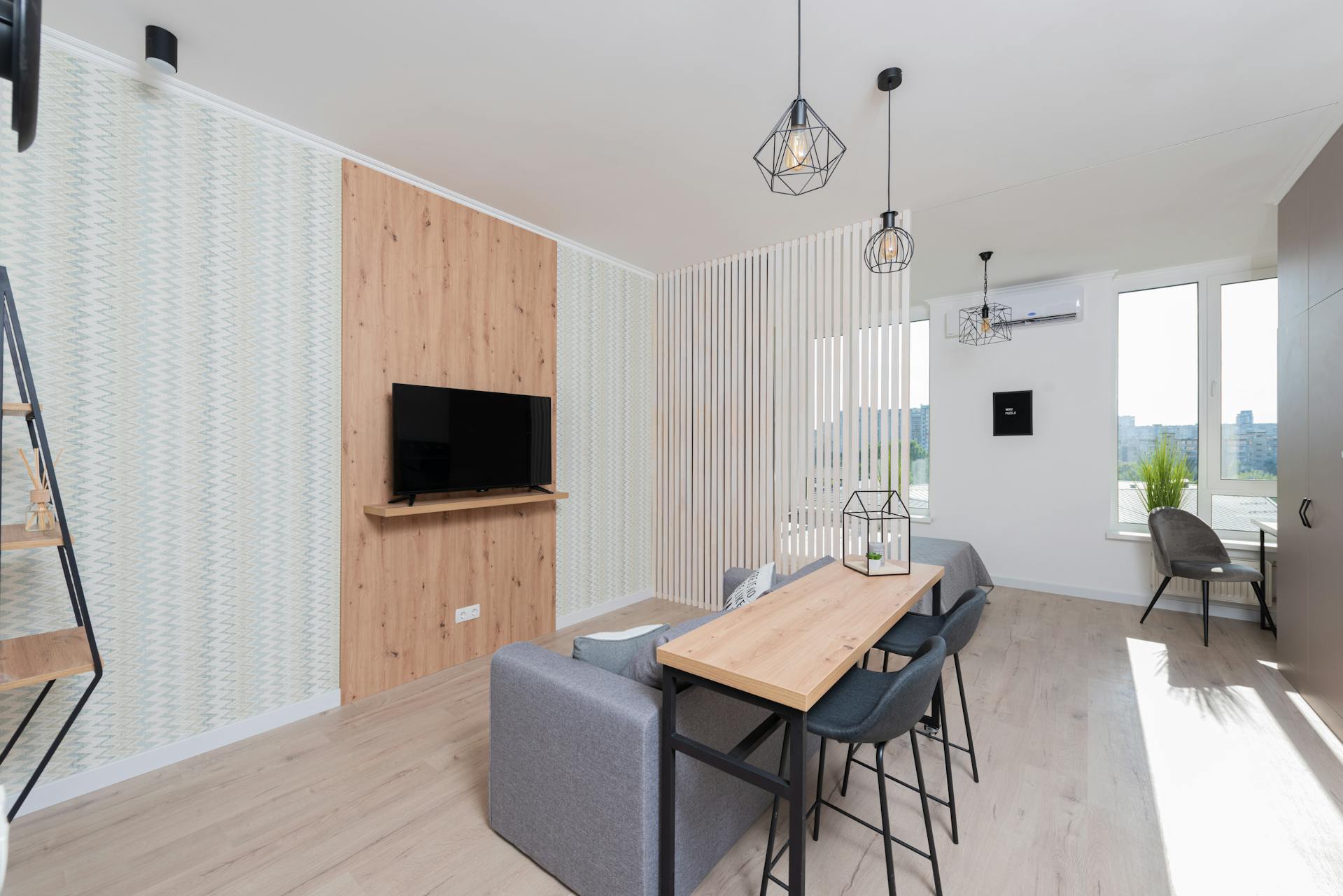How to Choose the Right Ceiling Design for Small Spaces
When designing a small space, every detail counts, and the ceiling is often one of the most overlooked elements. The right ceiling design can transform a compact room by creating the illusion of height, improving light distribution, and enhancing overall aesthetics. On the other hand, poor choices may make the area feel cramped or darker than it truly is. By carefully considering design, materials, and colors, homeowners can use ceilings to maximize comfort and style in limited spaces.
Using Light Colors to Create Height

Color plays a crucial role in how a ceiling affects a small room. Light shades such as white, cream, or soft pastels tend to open up spaces by reflecting light and drawing the eye upward. A ceiling painted in a lighter tone than the walls creates the impression of added height, making the room feel less confined. For modern interiors, a smooth, light-toned ceiling can provide a clean finish that amplifies natural or artificial lighting, giving the room a bright and airy atmosphere.
The Advantage of False Ceilings
False ceilings, also known as drop ceilings, can be highly effective in small spaces if designed thoughtfully. Instead of lowering the room, they can be used to incorporate recessed lighting, hide wiring, and create sleek finishes that reduce visual clutter. Choosing a false ceiling with minimal patterns or delicate grooves ensures that the space looks organized without overwhelming the eye. With the right design, false ceilings enhance functionality while still contributing to the perception of height and openness.
Adding Mirrors and Glossy Finishes
Reflective materials are another way to make ceilings work in favor of small rooms. A ceiling with glossy finishes or mirror panels bounces light around the space, creating a sense of expansion. When combined with strategic lighting, reflective ceilings give the illusion of greater depth and make compact interiors appear more spacious. Although not suitable for every style, this approach works particularly well in modern or minimalist settings where maximizing brightness is a priority.
The Role of Lighting in Ceiling Design

Ceiling design is not only about structure or paint but also about how lighting is integrated. Recessed lights, cove lighting, or slim LED strips installed within the ceiling can distribute illumination evenly, reducing shadows that make spaces appear smaller. Warm, indirect lighting creates a cozy atmosphere, while cool tones enhance sharpness and openness. The combination of ceiling design and lighting can completely redefine a room’s proportions, making it feel more welcoming and balanced.
Choosing Simple Patterns and Lines
While bold ceiling patterns can look impressive in larger rooms, small spaces require subtlety. Simple linear designs or minimal grooves add character without making the ceiling appear busy. Overly complex patterns or heavy materials can weigh down the space visually, shrinking its perceived size. Clean lines and understated textures allow the ceiling to complement the rest of the interior rather than compete with it, ensuring harmony throughout the room.
Selecting the right ceiling design for a small space is about finding a balance between function and style. Light colors, reflective finishes, integrated lighting, and simple patterns all help create the illusion of space while maintaining comfort. False ceilings, when used thoughtfully, can also add sophistication without overwhelming the room. By making smart design choices, homeowners can turn ceilings into powerful tools that enhance small interiors and make them feel more open, inviting, and aesthetically pleasing.…









 We all know the struggle. Life is indeed unpredictable. Sometimes, it throws curveballs your way. In these moments, having access to mobile locksmith services can be a game-changer. These professionals are equipped to come directly to you, whether you’re at home, work, or even stuck on the roadside. Their ability to provide assistance wherever you need it saves both time and stress. Imagine needing help late at night after losing your keys during an outing.
We all know the struggle. Life is indeed unpredictable. Sometimes, it throws curveballs your way. In these moments, having access to mobile locksmith services can be a game-changer. These professionals are equipped to come directly to you, whether you’re at home, work, or even stuck on the roadside. Their ability to provide assistance wherever you need it saves both time and stress. Imagine needing help late at night after losing your keys during an outing. Mobile locksmiths come equipped with specialized tools that make them highly efficient. Each tool is designed for specific tasks, whether picking locks or creating new keys on-site. Instead of struggling with generic hardware store solutions, these professionals have the right gear at their fingertips. They can quickly assess a situation and choose the most effective approach to resolve it.
Mobile locksmiths come equipped with specialized tools that make them highly efficient. Each tool is designed for specific tasks, whether picking locks or creating new keys on-site. Instead of struggling with generic hardware store solutions, these professionals have the right gear at their fingertips. They can quickly assess a situation and choose the most effective approach to resolve it.


 In maintaining a clean and tidy home, dusting, vacuuming, and mopping are the holy trinity of cleaning tasks. Dust bunnies, beware. A professional cleaner from these cleaning services in bournemouth will meticulously dust all surfaces in your home, from shelves to picture frames, ensuring every nook and cranny is free of pesky particles. Next up, say goodbye to crumbs and debris with a thorough vacuuming session. Your floors will thank you as dirt and dust are sucked away, leaving behind fresh carpets or gleaming hardwood.
In maintaining a clean and tidy home, dusting, vacuuming, and mopping are the holy trinity of cleaning tasks. Dust bunnies, beware. A professional cleaner from these cleaning services in bournemouth will meticulously dust all surfaces in your home, from shelves to picture frames, ensuring every nook and cranny is free of pesky particles. Next up, say goodbye to crumbs and debris with a thorough vacuuming session. Your floors will thank you as dirt and dust are sucked away, leaving behind fresh carpets or gleaming hardwood.






 Medium-Density Fiberboard (MDF) is a popular material for standing desk surfaces due to its affordability and versatility. Made from compressed wood fibers, MDF offers a smooth surface that’s easy to clean and maintain. One of the benefits of MDF is its consistency in density throughout the board, which means it won’t warp or split like solid wood can over time. This makes it an excellent choice for those looking for long-term durability in their standing desk.
Medium-Density Fiberboard (MDF) is a popular material for standing desk surfaces due to its affordability and versatility. Made from compressed wood fibers, MDF offers a smooth surface that’s easy to clean and maintain. One of the benefits of MDF is its consistency in density throughout the board, which means it won’t warp or split like solid wood can over time. This makes it an excellent choice for those looking for long-term durability in their standing desk.



 Many of the homes in Singapore are smart
Many of the homes in Singapore are smart  We know now that Singapore is a very modern and technologically advanced country. The government places a lot of emphasis on sustainability and green living, which has resulted in the development of eco-friendly homes. In addition, Singapore is a very multicultural country, reflected in its architecture. These factors make Singapore an ideal place to live for people from all walks of life. What are your thoughts? Are you considering a move to Singapore?…
We know now that Singapore is a very modern and technologically advanced country. The government places a lot of emphasis on sustainability and green living, which has resulted in the development of eco-friendly homes. In addition, Singapore is a very multicultural country, reflected in its architecture. These factors make Singapore an ideal place to live for people from all walks of life. What are your thoughts? Are you considering a move to Singapore?…
 One of the most common methods of
One of the most common methods of  Cinnamon is a spice that you can use to keep bees away. Mix the cinnamon with water in a spray bottle and apply it to areas where bees are congregating. You can also sprinkle cinnamon around the perimeter of your property. The strong smell will deter bees from entering your yard. This method is also effective against wasps and ants. There you have it—four bee removal methods that don’t involve killing them.
Cinnamon is a spice that you can use to keep bees away. Mix the cinnamon with water in a spray bottle and apply it to areas where bees are congregating. You can also sprinkle cinnamon around the perimeter of your property. The strong smell will deter bees from entering your yard. This method is also effective against wasps and ants. There you have it—four bee removal methods that don’t involve killing them.
 One of the significant factors in this process is the size. Depending on the number of flocks you have, it is advisable to allow a minimum of five square feet of floor space for each hen in the coop. If you have larger breeds in a situation, you will need to have a cage that is closer to five square feet per hen.
One of the significant factors in this process is the size. Depending on the number of flocks you have, it is advisable to allow a minimum of five square feet of floor space for each hen in the coop. If you have larger breeds in a situation, you will need to have a cage that is closer to five square feet per hen. When planning to have flocks in your area, you should ensure you understand how to keep them safe from predators while they are asleep. Also, you must ensure they are always comfortable. That is why you need to realize that adequate ventilation in your coop is essential, and they need to be high in the chicken coop for quality airflow around. Avoid chicken coops with no ventilations because they can cause eye irritation or respiratory issues on your chicken.
When planning to have flocks in your area, you should ensure you understand how to keep them safe from predators while they are asleep. Also, you must ensure they are always comfortable. That is why you need to realize that adequate ventilation in your coop is essential, and they need to be high in the chicken coop for quality airflow around. Avoid chicken coops with no ventilations because they can cause eye irritation or respiratory issues on your chicken.
 When mold in the house becomes airborne, the air quality in the home declines significantly. Mold symptoms and exposure happen when the spores are inhaled in the air and settle in nasal passages and lungs. A remediation expert can test the indoor air quality to find out signs of the spores. They are also able to perform extensive inspections for the possibility of mold growth in the home. If found, professional mold testing is done to establish if there is a risk of toxic exposure.
When mold in the house becomes airborne, the air quality in the home declines significantly. Mold symptoms and exposure happen when the spores are inhaled in the air and settle in nasal passages and lungs. A remediation expert can test the indoor air quality to find out signs of the spores. They are also able to perform extensive inspections for the possibility of mold growth in the home. If found, professional mold testing is done to establish if there is a risk of toxic exposure.
 The more popular a termite control agency is, the more reputable it is. Termite infestations happen everywhere, and many people prefer hiring professionals to do the extermination for them. If you are hiring an agency to do this for you, you will need to be sure that they are trustworthy. It is the best way to guarantee they will give you good quality services.
The more popular a termite control agency is, the more reputable it is. Termite infestations happen everywhere, and many people prefer hiring professionals to do the extermination for them. If you are hiring an agency to do this for you, you will need to be sure that they are trustworthy. It is the best way to guarantee they will give you good quality services.






 on mice. These insects can be found in different parts of your home and they transmit the disease through biting. You are likely to suffer from dermatitis which is characterized by symptoms such as itchiness on your skin, the formation of blisters, and also inflammation.
on mice. These insects can be found in different parts of your home and they transmit the disease through biting. You are likely to suffer from dermatitis which is characterized by symptoms such as itchiness on your skin, the formation of blisters, and also inflammation. other pets. You can also get them when playing outside in areas with bushes or long grass. Ticks suck your blood and infect you with this condition which has symptoms such as joint weakness and flu. You should get rid of pests in your home to stay free from such diseases.…
other pets. You can also get them when playing outside in areas with bushes or long grass. Ticks suck your blood and infect you with this condition which has symptoms such as joint weakness and flu. You should get rid of pests in your home to stay free from such diseases.…
 ideal tools for the job. Most of them will come with modern equipment and machinery like tractors if you have a bigger compound.
ideal tools for the job. Most of them will come with modern equipment and machinery like tractors if you have a bigger compound.  Plants are mostly used during the process to leave your home looking good. This is vital for nature preservation. You don’t have to cut down trees to create space because you can use them to leave your home looking good. Plant more trees to give room for the continuity of growth. How about you carry out these practices in your home and enjoy the benefits.…
Plants are mostly used during the process to leave your home looking good. This is vital for nature preservation. You don’t have to cut down trees to create space because you can use them to leave your home looking good. Plant more trees to give room for the continuity of growth. How about you carry out these practices in your home and enjoy the benefits.…
 Some blinds require a large stack at the top of the window. This is especially true to heavy blinds like faux wood. By having a large top stack, the entry of light may be decreased when the blinds are raised. For shorter windows, lighter blinds are recommended while massive windows can have heavier kinds of blinds.
Some blinds require a large stack at the top of the window. This is especially true to heavy blinds like faux wood. By having a large top stack, the entry of light may be decreased when the blinds are raised. For shorter windows, lighter blinds are recommended while massive windows can have heavier kinds of blinds. Some types of blinds are not always available in the market, and notably, those are wood blinds. In some countries, wood blinds have become rare because of the scarcity of wood. You can either buy prefabricated wood blinds or let a professional make them for you.
Some types of blinds are not always available in the market, and notably, those are wood blinds. In some countries, wood blinds have become rare because of the scarcity of wood. You can either buy prefabricated wood blinds or let a professional make them for you.

 One basic and conventional way of installing lamps, any lamp, in your house is by hanging them up under the ceiling. Magically, it works really well with the string lights as well. You can try installing them under the ceiling crossing the room in the forms of big waves or the smaller ones. For more ideas, many creative references are available pretty much everywhere on the Internet and social media.
One basic and conventional way of installing lamps, any lamp, in your house is by hanging them up under the ceiling. Magically, it works really well with the string lights as well. You can try installing them under the ceiling crossing the room in the forms of big waves or the smaller ones. For more ideas, many creative references are available pretty much everywhere on the Internet and social media.
 The company you select should be preferable ten years old in the business. The reason for this is because spray foam insulation usually starts showing problems after four or five years. Manufacturers typically offer warranties for the material cost. Most companies make the mistake of using foam based on the price, and after four years many customers start calling them to fix their problems. This makes some of them disappear. Choosing a ten-year-old company assures you of the best quality service and material, and they will honor their guarantee.
The company you select should be preferable ten years old in the business. The reason for this is because spray foam insulation usually starts showing problems after four or five years. Manufacturers typically offer warranties for the material cost. Most companies make the mistake of using foam based on the price, and after four years many customers start calling them to fix their problems. This makes some of them disappear. Choosing a ten-year-old company assures you of the best quality service and material, and they will honor their guarantee.

 Overstretching your hands or hanging on a ladder is the easiest way to discourage yourself from ever cleaning your blinds again. It is better to remove them before the cleaning process for accessibility and comfortability. Take off the blinds from the rail and remove the cord lock, then lay it on a flat surface. Ensure the surface is clean.
Overstretching your hands or hanging on a ladder is the easiest way to discourage yourself from ever cleaning your blinds again. It is better to remove them before the cleaning process for accessibility and comfortability. Take off the blinds from the rail and remove the cord lock, then lay it on a flat surface. Ensure the surface is clean. When the blinds are totally dry, make sure to hang it back to the window. Reinstall the cord and blind to the rail just as you had removed it. So that is how to clean your pleated blinds. If it is possible, endeavor to clean them daily but this time with just the damp sponge. Using a fabric cleaner daily would weaken the fabric of the blinds, so you might want to avoid doing that. The air around you becomes fresher when you clean daily.…
When the blinds are totally dry, make sure to hang it back to the window. Reinstall the cord and blind to the rail just as you had removed it. So that is how to clean your pleated blinds. If it is possible, endeavor to clean them daily but this time with just the damp sponge. Using a fabric cleaner daily would weaken the fabric of the blinds, so you might want to avoid doing that. The air around you becomes fresher when you clean daily.…
 Affordability
Affordability A Wide Variety
A Wide Variety Bats are a protected species in most states. Thus, bat removal is often a controlled process that is governed by some law. You are advised against bat extermination of risk serious fines. This implies that you are legally mandated to use only humane ways to evict these unwanted guests. One human approach is to build a bat house and force them to relocate there.
Bats are a protected species in most states. Thus, bat removal is often a controlled process that is governed by some law. You are advised against bat extermination of risk serious fines. This implies that you are legally mandated to use only humane ways to evict these unwanted guests. One human approach is to build a bat house and force them to relocate there. valves. These valves allow bats to get out and deter them from regaining access. Once there are no bats inside, the next step should be to clean the droppings and urine in their wake.
valves. These valves allow bats to get out and deter them from regaining access. Once there are no bats inside, the next step should be to clean the droppings and urine in their wake.

 A potential buyer needs to imagine themselves living in the home. A house that has the seller’s personal items and touch may be a little difficult to achieve these image. It is important for the homeowner to remove any personal stuff like family pictures and pets. This will help the potential buyer own the home. It can also help to stage the house to help improve and maximize the potential of the space in the house.
A potential buyer needs to imagine themselves living in the home. A house that has the seller’s personal items and touch may be a little difficult to achieve these image. It is important for the homeowner to remove any personal stuff like family pictures and pets. This will help the potential buyer own the home. It can also help to stage the house to help improve and maximize the potential of the space in the house.





 This is the most popular every review website and clients are discussing today. The 10-inch circular shower head is a ceiling mount and durable brass finish piece. It will not only enhance the aesthetics of your bathroom but will also give you the most amazing rain shower anytime. The easy installation and maintenance options is also another plus. The surface will not corrode or get scratches anytime soon. If you are looking good value for money, then you can rest assured that this rain shower head did not surcharge you.
This is the most popular every review website and clients are discussing today. The 10-inch circular shower head is a ceiling mount and durable brass finish piece. It will not only enhance the aesthetics of your bathroom but will also give you the most amazing rain shower anytime. The easy installation and maintenance options is also another plus. The surface will not corrode or get scratches anytime soon. If you are looking good value for money, then you can rest assured that this rain shower head did not surcharge you. Another 10-inch diameter great shower head for people who value style and functionality. It is a heavy and compact piece of high quality chrome which is ceiling mounted. The rain air spray mode has given this piece a reputation. This mixes every drop of water with air resulting to soft and soothing shower experience for all moments. However, expect to pay a little bit higher for this option than any other on the list.
Another 10-inch diameter great shower head for people who value style and functionality. It is a heavy and compact piece of high quality chrome which is ceiling mounted. The rain air spray mode has given this piece a reputation. This mixes every drop of water with air resulting to soft and soothing shower experience for all moments. However, expect to pay a little bit higher for this option than any other on the list.
 e, you may find out that using their services may not make an economic change. In some parts, there are few landscaping firms. This makes it difficult to find those that can work for you is a huge challenge. No matter the case, or regardless of where you come from, you will need professional people to do landscaping for you. It is advisable to have different bidders submit their best rates. You need to look into them against the technical experience and competence, in choosing whom to offer you a job.
e, you may find out that using their services may not make an economic change. In some parts, there are few landscaping firms. This makes it difficult to find those that can work for you is a huge challenge. No matter the case, or regardless of where you come from, you will need professional people to do landscaping for you. It is advisable to have different bidders submit their best rates. You need to look into them against the technical experience and competence, in choosing whom to offer you a job. ticular approach, you will find it suitable for small projects. Such projects do not warrant a tender or an open advertisement. You will find it to be a good approach if you are in this part of the world, where there are few landscaping companies. Also, in some cases, an advertisement may not attract lots of firms.
ticular approach, you will find it suitable for small projects. Such projects do not warrant a tender or an open advertisement. You will find it to be a good approach if you are in this part of the world, where there are few landscaping companies. Also, in some cases, an advertisement may not attract lots of firms.




 your locality will be equipped with the most recent and advanced tools as well as scientific devices which will aid them to make new locks, fix erratic old locks, unlock any accidentally locked door and so on. In a nutshell, they will use their modern equipment to make your locks function smoothly once again. You will be assured of getting all types of locksmith services under one roof only. One must be prepared for an emergency situation which might arise any moment.
your locality will be equipped with the most recent and advanced tools as well as scientific devices which will aid them to make new locks, fix erratic old locks, unlock any accidentally locked door and so on. In a nutshell, they will use their modern equipment to make your locks function smoothly once again. You will be assured of getting all types of locksmith services under one roof only. One must be prepared for an emergency situation which might arise any moment.



 Are they strong?
Are they strong?
 Have you ever tried to transport some items using your family van? That is funny! The only way not to look funny is to ensure that engage a professional mover to handle this for you. When it comes to moving, there is nothing impossible for them. They have the right equipment to handle heavy furniture. They can dismantle and assemble big items with ease. For your information, you will just mess up things if you try to do it yourself. Simply do not.
Have you ever tried to transport some items using your family van? That is funny! The only way not to look funny is to ensure that engage a professional mover to handle this for you. When it comes to moving, there is nothing impossible for them. They have the right equipment to handle heavy furniture. They can dismantle and assemble big items with ease. For your information, you will just mess up things if you try to do it yourself. Simply do not. Reputable companies usually have insurance covers for the work they do. As much as they ensure the maximum level of care when they are handling your belongings, there is hope just in case anything happens to them. Should there be damage, accident or theft during the transportation, then, the insurance takes care of the cost. Be sure to confirm that the insurance company has a valid insurance before hiring them.
Reputable companies usually have insurance covers for the work they do. As much as they ensure the maximum level of care when they are handling your belongings, there is hope just in case anything happens to them. Should there be damage, accident or theft during the transportation, then, the insurance takes care of the cost. Be sure to confirm that the insurance company has a valid insurance before hiring them.

 ook for a reliable realtor. They are the people who are very well aware of the surroundings and the vicinity where you want to buy the property. It is important that you insist your realtor arrange appointments so that you can personally visit the house of your interest and view the home. Ensure to examine the home and check on the fixtures and finishing.
ook for a reliable realtor. They are the people who are very well aware of the surroundings and the vicinity where you want to buy the property. It is important that you insist your realtor arrange appointments so that you can personally visit the house of your interest and view the home. Ensure to examine the home and check on the fixtures and finishing.
 This means, the demand for rental condos will be more during summer. On the other hand, during winter, the selling price of beach condos goes down. Moreover, it will be easier to negotiate the sale price with the owner. Now, the question is how you are going to choose the appropriate condo for yourself. You may get confused as many condos are already available for sale. Following few guiding tips can help you in clearing out this confusion.
This means, the demand for rental condos will be more during summer. On the other hand, during winter, the selling price of beach condos goes down. Moreover, it will be easier to negotiate the sale price with the owner. Now, the question is how you are going to choose the appropriate condo for yourself. You may get confused as many condos are already available for sale. Following few guiding tips can help you in clearing out this confusion. these factors, you also need to decide whether you wish to buy used condos or new ones since the selling price may vary on this factor.…
these factors, you also need to decide whether you wish to buy used condos or new ones since the selling price may vary on this factor.…
 Many central heating systems fail sooner than necessary because they did not have the right maintenance. Replacement parts and labor for air ducts and heating systems can be very pricey, so consistent cleaning can help you avoid issues down the road.
Many central heating systems fail sooner than necessary because they did not have the right maintenance. Replacement parts and labor for air ducts and heating systems can be very pricey, so consistent cleaning can help you avoid issues down the road. Unfortunately, many people go the wrong way. First of all, you do not need chemicals. Many people use harsh chemicals to clean the systems, but this often causes more harm than good. A lot of chemicals that are effective for getting rid of the dirt are bad to breathe in, and as a result, you are just making the problem worse.
Unfortunately, many people go the wrong way. First of all, you do not need chemicals. Many people use harsh chemicals to clean the systems, but this often causes more harm than good. A lot of chemicals that are effective for getting rid of the dirt are bad to breathe in, and as a result, you are just making the problem worse.

 move your home and sell it without asking you do all the stressful marketing and real estate stuff as well, but it doesn’t have to be that way. By making use of a realtor, they can do all of the legwork and handle the dirty work that goes along with selling the home so you can focus on what is important and still get your home sold.
move your home and sell it without asking you do all the stressful marketing and real estate stuff as well, but it doesn’t have to be that way. By making use of a realtor, they can do all of the legwork and handle the dirty work that goes along with selling the home so you can focus on what is important and still get your home sold.
 on the specifics of your area to determine the best time to put your condo on the market.It was suggested that the best time when buyers are aggressive with their pricing is the spring. However, this theory does not hold true now, and it depends mainly on the location of the condo. Moreover, real estate agents are well aware of the best time of selling so leaving the responsibility to them will raise the selling chances of your condo.
on the specifics of your area to determine the best time to put your condo on the market.It was suggested that the best time when buyers are aggressive with their pricing is the spring. However, this theory does not hold true now, and it depends mainly on the location of the condo. Moreover, real estate agents are well aware of the best time of selling so leaving the responsibility to them will raise the selling chances of your condo. Along with your real estate agent, you should point out the best feature of your condo. It can be the location of your condo, a well-equipped parking space and much more. Buyers tend to look for the advantages that are present with your condo so you need to exploit one crucial factor that will eventually help you in selling your condo at the best available price.
Along with your real estate agent, you should point out the best feature of your condo. It can be the location of your condo, a well-equipped parking space and much more. Buyers tend to look for the advantages that are present with your condo so you need to exploit one crucial factor that will eventually help you in selling your condo at the best available price.
 First of all, ask your roofing contractor about insurance, especially liability, and compensation. This is to make sure that all the roofers working in your place are insured. With the roofing contractor’s liability and compensation insurance all ready and set for their workers, you are excluded from any mishappening that may happen during work. Ask for their policy certificates and then contact the insurance company to validate the information.
First of all, ask your roofing contractor about insurance, especially liability, and compensation. This is to make sure that all the roofers working in your place are insured. With the roofing contractor’s liability and compensation insurance all ready and set for their workers, you are excluded from any mishappening that may happen during work. Ask for their policy certificates and then contact the insurance company to validate the information. Request for a written contract. While a handshake is the sign of a courteous roofing contractor, you will still need to have all the terms and conditions in writing. This includes the material, the specification and the scope of the project.
Request for a written contract. While a handshake is the sign of a courteous roofing contractor, you will still need to have all the terms and conditions in writing. This includes the material, the specification and the scope of the project.



 Landscaping services are those that services that improve the aesthetic appeal of an open space like garden or courtyards. It does so by a number of ways like planting different types of trees, ornamenting the area with different features and altering its contours.
Landscaping services are those that services that improve the aesthetic appeal of an open space like garden or courtyards. It does so by a number of ways like planting different types of trees, ornamenting the area with different features and altering its contours. Maintenance of landscapes is one of the prime services offered by these companies. They make sure that a garden is properly mowed, herbs and shrubs regularly trimmed, new plants planted, dead plants removed, dead leaves collected and disposed of. They also make sure that there is proper irrigation and pesticides applied from time to time. They offer both tree and shrub removal and lawn and landscape maintenance services too.…
Maintenance of landscapes is one of the prime services offered by these companies. They make sure that a garden is properly mowed, herbs and shrubs regularly trimmed, new plants planted, dead plants removed, dead leaves collected and disposed of. They also make sure that there is proper irrigation and pesticides applied from time to time. They offer both tree and shrub removal and lawn and landscape maintenance services too.… It is essential for you to protect your home, the people, and property within it, even when a monthly home security system is outside your budget.There are plenty of cheap and reasonable ways to make your home less attractive to burglars and thieves.
It is essential for you to protect your home, the people, and property within it, even when a monthly home security system is outside your budget.There are plenty of cheap and reasonable ways to make your home less attractive to burglars and thieves. Within the last few years alone, the use of intercom systems as a mode of communication has sharply gone up. You can use it in a wide range of different situations, and with availability of wireless systems, they are now quite affordable and unbelievably easy to install.
Within the last few years alone, the use of intercom systems as a mode of communication has sharply gone up. You can use it in a wide range of different situations, and with availability of wireless systems, they are now quite affordable and unbelievably easy to install.